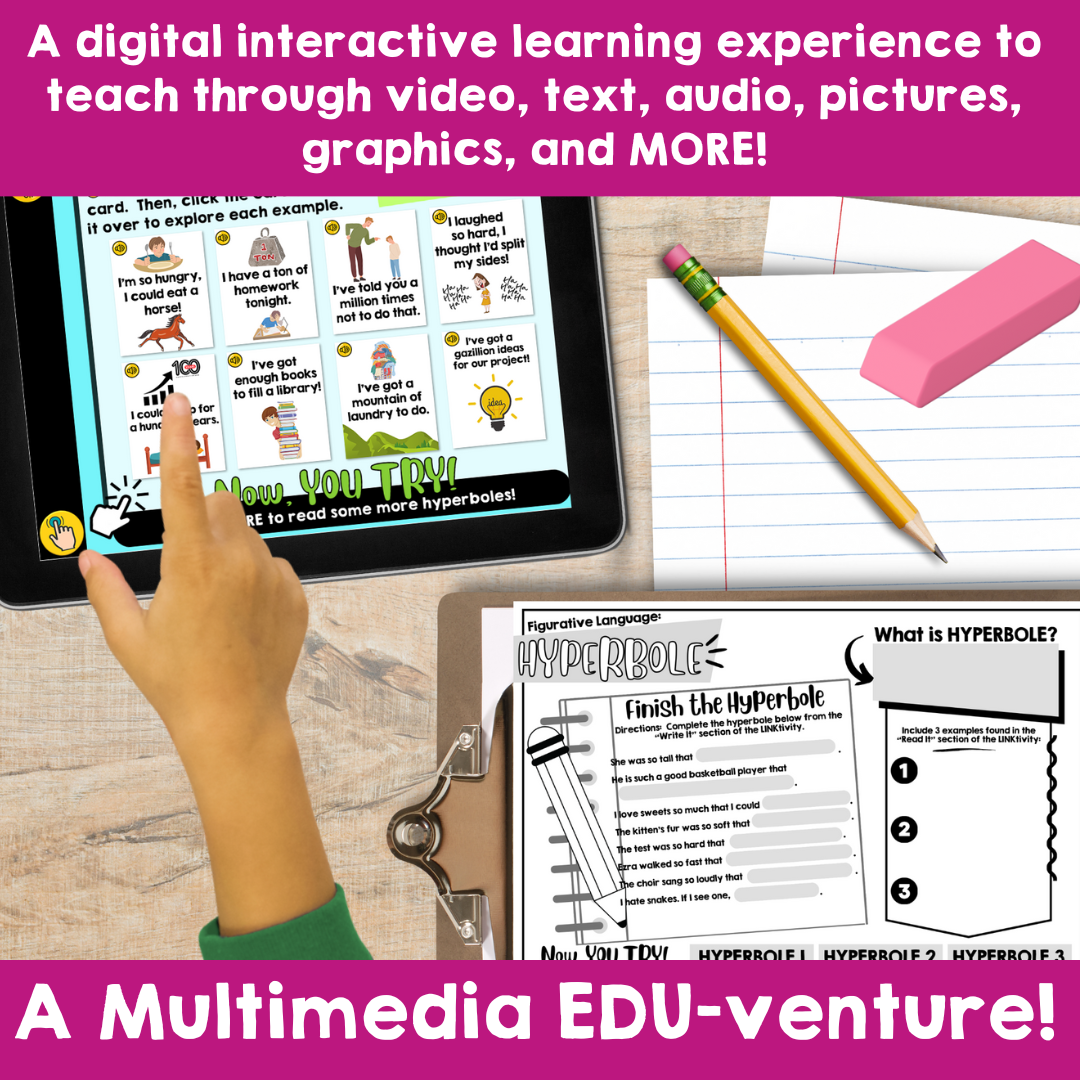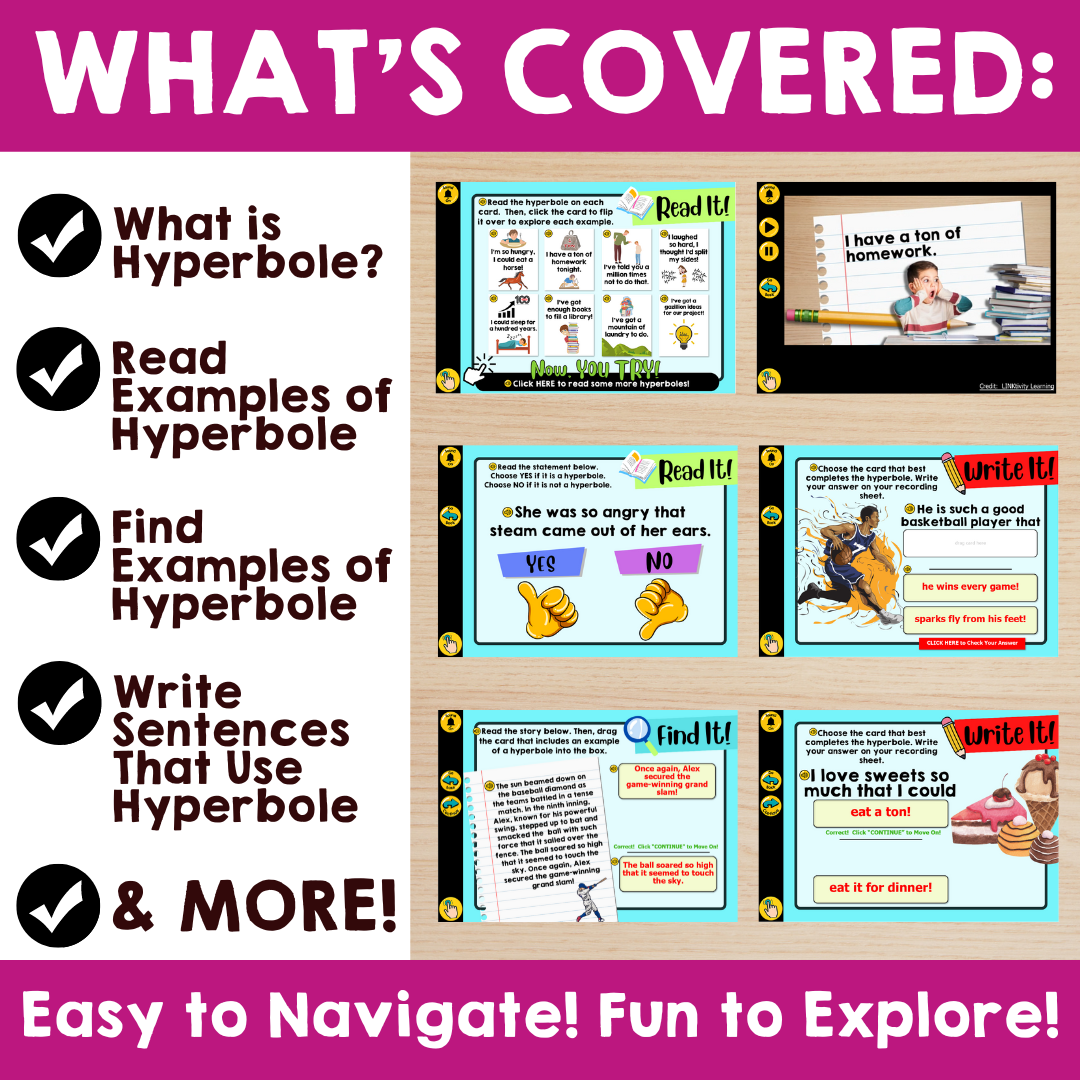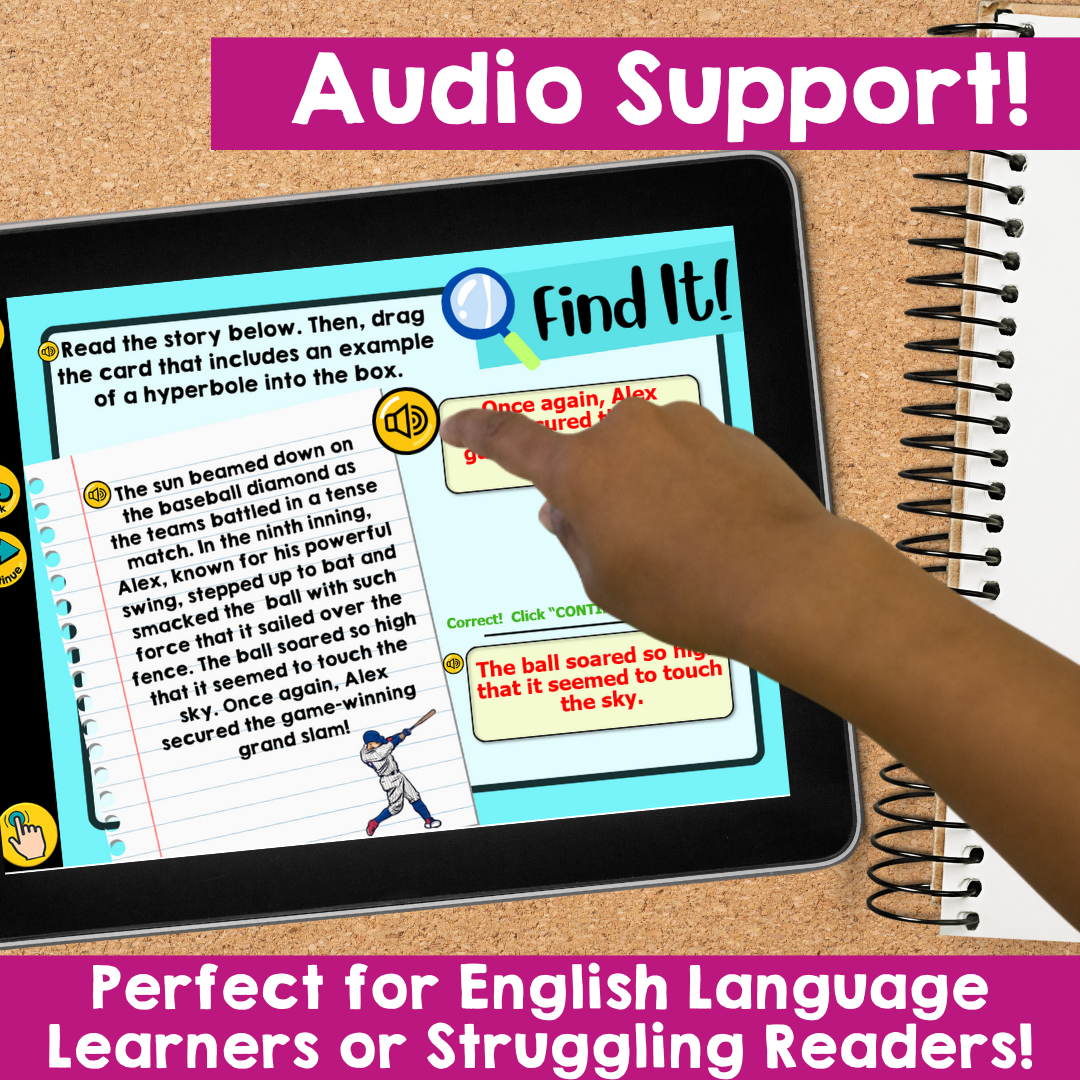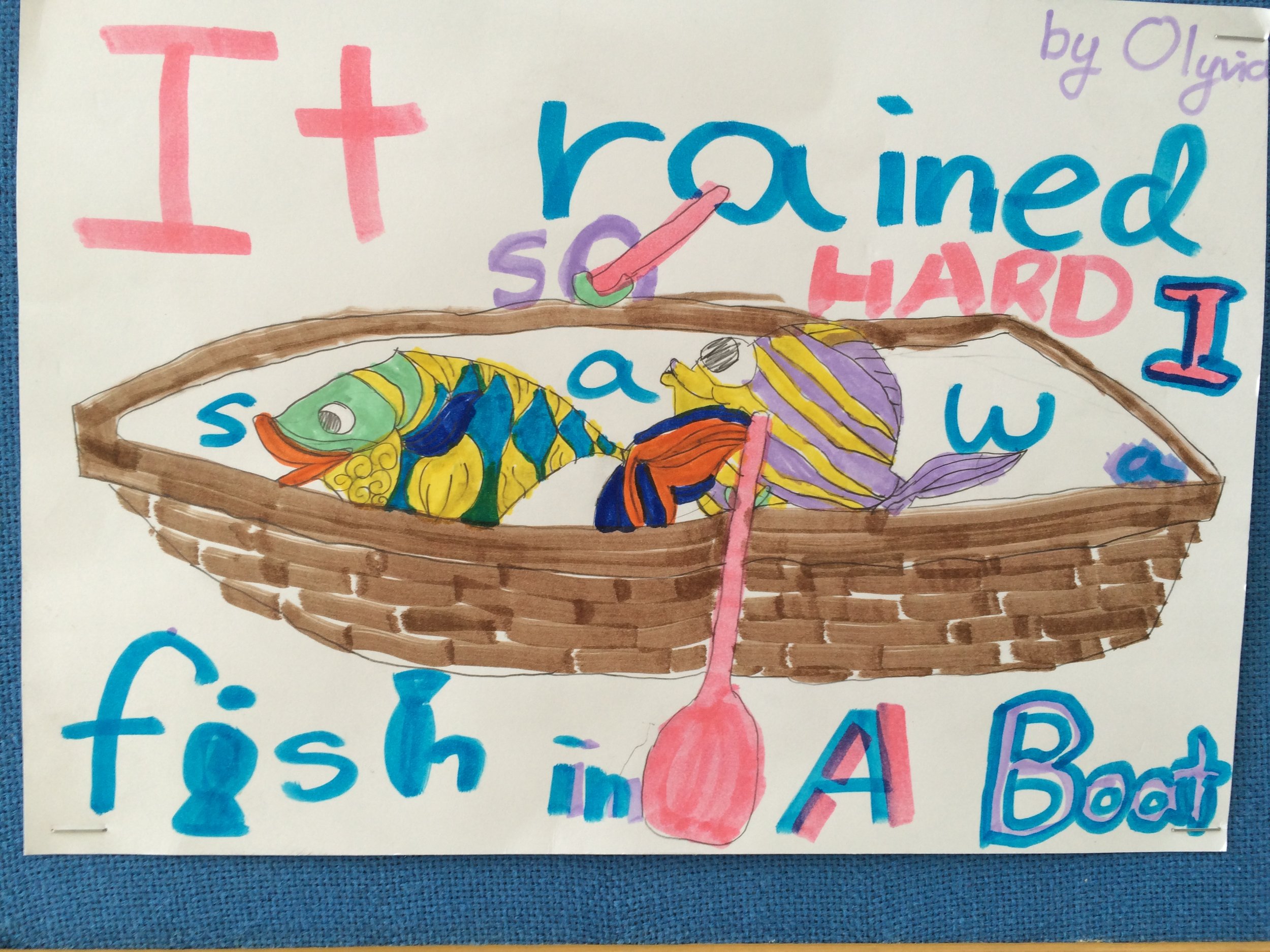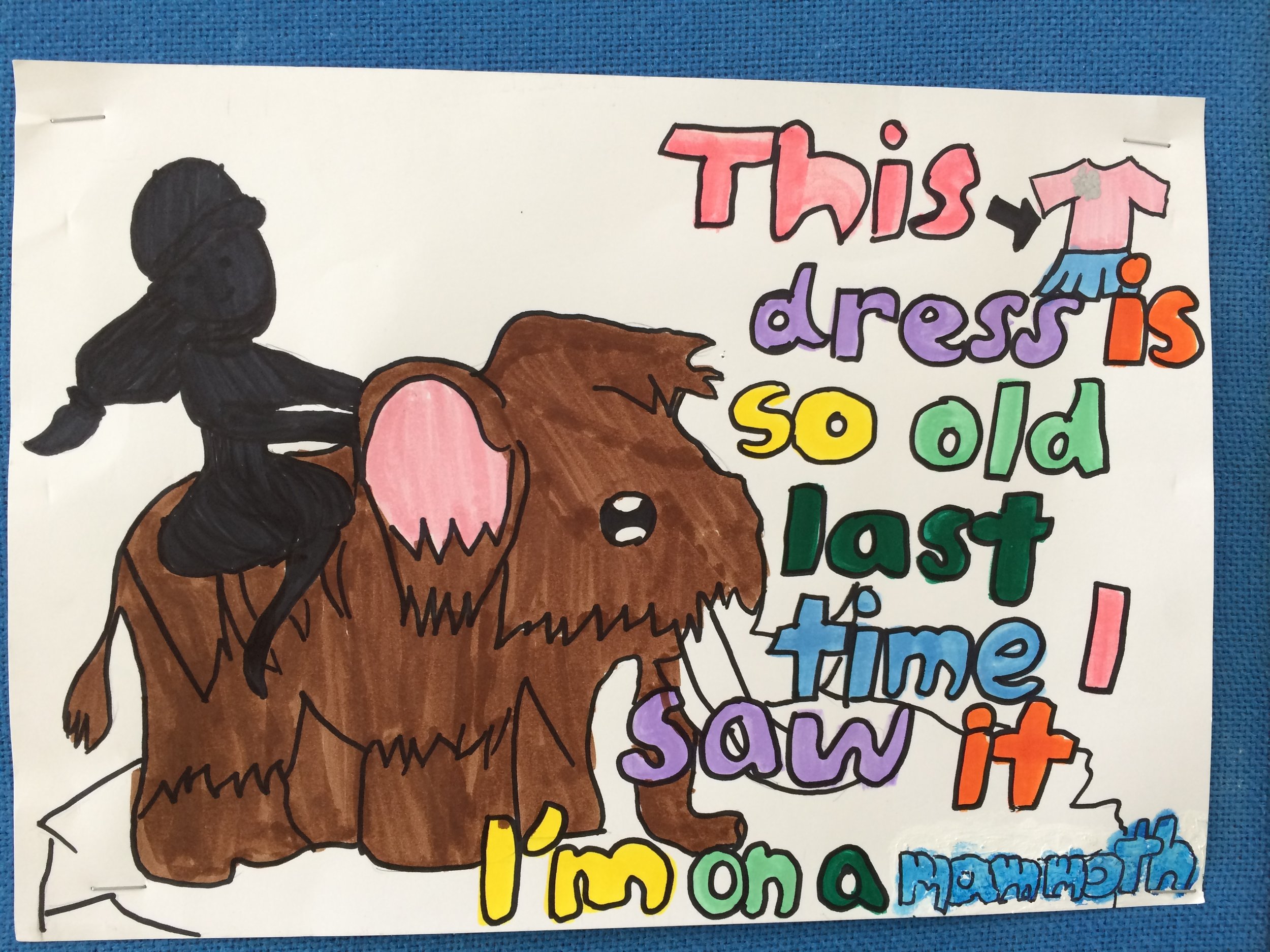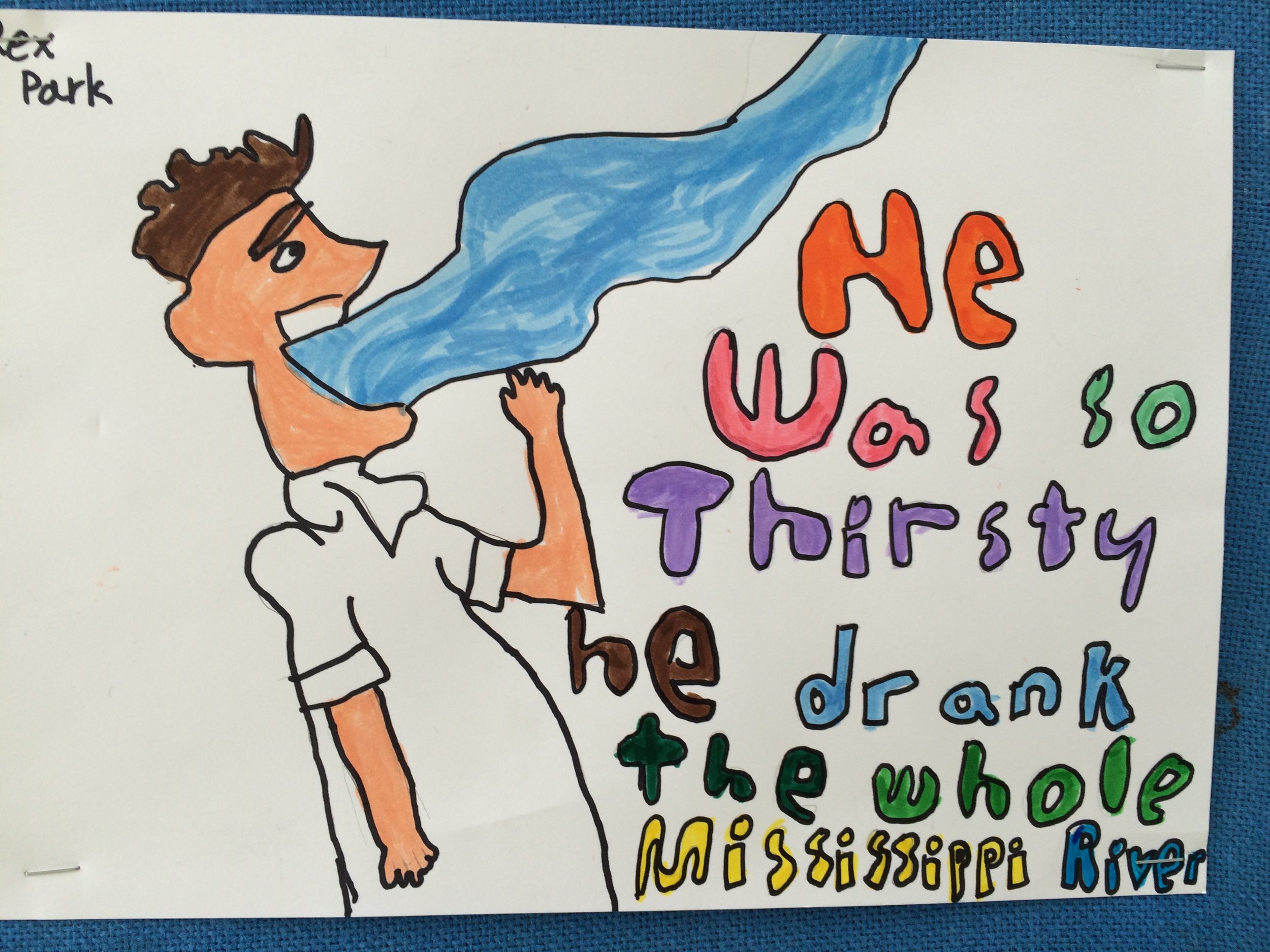Hyperbole Lessons & Activities That Will Make Your Class Roar with Laughter
Of all the types of figurative language that we can teach our students, hyperboles might just be my favorite! That’s because students tend to love listening to and using hyperboles in speech and writing, and there are a lot of creative hyperbole activities that you can complete with your students to make learning fun and engaging!
Hyperboles aren't just about stretching the truth or exaggerating for effect; they're a gateway to unleashing boundless imagination and linguistic ability in our students.
Using hyperbole holds immense potential for developing language skills and fostering creativity in young minds. By mastering hyperboles, students can elevate their reading comprehension, writing proficiency, and communication abilities.
In this post, we'll explore hyperboles, from their exaggerated essence to their practical applications.
If you’ve been following along, you’ll note that this post is part of a 6-part series all about how to teach figurative language to your students. We’re tackling each figure of speech one by one so that you can walk away with tips and tools for your third, fourth, or fifth graders!
Other Posts in this Series
Personification (Coming Soon!)
Onomatopoeias (Coming Soon!)
Idioms (Coming Soon!)
Understanding Hyperboles:
Let's start with the basics: What exactly are hyperboles? Well, think of them as those over-the-top statements that are meant to be taken with a grain of salt — an extreme exaggeration.
They're like the superheroes of language, swooping in to emphasize a point or paint a vivid picture in our minds.
For example, when you say, "I could sleep forever" or "I have a ton of homework," you're using hyperbole to exaggerate for effect.
Keep in mind that oftentimes the use of a hyperbole will overlap with similes and metaphors. For example, the phrase: “She’s as tall as a skyscraper” could fall under the hyperbole AND simile categories. However, that doesn’t mean all similes and metaphors are hyperboles, but it’s worth pointing out the connection to students as you come across them.
Using hyperboles not only adds flair to language but also helps students develop their creativity and critical thinking skills. Plus, they make reading and writing more engaging and exciting! Hyperboles help students become more effective communicators and expressive writers.
Introducing Hyperboles:
To help students grasp the concept of hyperboles, start with some relatable examples. Think about those times when you've said, "I'm so hungry I could eat a horse" or "I'm dying of boredom." These statements might seem a bit dramatic, but they perfectly illustrate the power of hyperbole, and are certainly phrases students have likely used before.
Point out that students might already be using hyperboles and not even realize it! Ask students to imagine being so hungry that they could devour an entire horse! Or feeling so bored that it's as if time has come to a standstill. These exaggerated expressions capture intense emotions and emphasize the speaker's feelings in a way that's both amusing and insightful.
Creating a simple anchor chart outlining common hyperboles is a great place to start.
By pointing out hyperboles in everyday language, students can start to recognize them in the wild and understand their purpose. Whether it's hearing a friend say, "I've told you a million times!" or watching a character in a movie exclaim, "I'm the luckiest person in the world!" hyperboles are all around us.
FREE POSTERS
Snag this FREE set of 7 posters to display in your classroom as you teach about types of figurative language.
They add color and excitement to our conversations and stories, helping us convey our emotions and experiences in a more vivid and engaging manner.
You may even want to create a class anchor chart entitled: “Hyperboles in the Wild!” where students add a sticky note each time they hear or use a hyperbole in their everyday life.
Mentor Texts That Use Hyperbole:
After introducing hyperbole, the next logical step is to demonstrate how authors use this literary device in their writing. This can be achieved through the use of mentor texts.
To begin, gather a variety of mentor texts and read through them yourself, paying close attention to instances where hyperbole is employed. Take note of these examples as you read, as they will serve as valuable teaching tools for your students.
Once you have identified hyperboles within the mentor texts, highlight them for your students during a mini-lesson. Show them how authors use hyperbole to add flair and interest to their writing, making it more engaging for the reader.
Consider creating a collection of these hyperbole statements from each mentor text on sticky notes and arranging them on an anchor chart. This visual aid will help students better understand and remember how hyperbole is used in literature.
To further reinforce their understanding, divide students into small groups and provide each group with a mentor text to read independently. Instruct them to identify hyperboles as they read and discuss their findings with their group members.
This collaborative activity will allow students to practice identifying hyperbole in context and deepen their comprehension of how it contributes to the overall meaning and impact of a text.
By incorporating mentor texts and hands-on activities, you can effectively demonstrate the use of hyperbole in literature and help students develop a keen awareness of this figurative language device in their own reading and writing.
Here is a list of potential books to use for finding hyperbole
“Cloudy With a Chance of Meatballs” by Judi Barret
“Alexander and the Terrible, No Good, Very Bad Day” by Judith Viorst
"Don't Let the Pigeon Drive the Bus!" by Mo Willems
“Paul Bunyan” by Steven Kellogg
“A Million Fish…More or Less” by Patricia McKissack
“Steamboat Annie and the Thousand-Pound Catfish” by Catherine Wright
“Thunder Rose” by Jeredine Nolen
“Kate and the Beanstalk” by Mary Pope Osborne
“Piggie Pie” by Margie Palatini
“Widdermaker” by Pattie Schnetzler
Engaging Activities for Practicing How to Use Hyperboles
When teaching a new skill, I like to have a mix of whole group, small group, and individual practice to gradually release the reins to students and to give them a variety of experiences that keep learning fresh.
Hyperbole Match-Up
A fantastic whole-group activity to introduce hyperboles to your students is a Match-Up game. This game is not only simple to set up but also fun to play!
All you'll need are two sets of cards: one set with literal language phrases and another set with corresponding hyperbole statements.
For instance, one card might read: "I'm as hungry as a horse!" while its matching card could say: "I'm very hungry."
Make sure you have enough cards so that each student receives either a literal language card or a hyperbole language card.
Need a quick and convenient way to generate a list of literal versus hyperbole cards?
Enter ChatGPT, your newest teaching ally! ChatGPT is a free AI tool that can streamline various aspects of your teaching life (but that’s a blog post for another day!). It has the ability to generate content for you with just a simple prompt.
To create your match-up cards, simply head to ChatGPT (if you haven't already, sign up for a free account) and use the following prompt: "Give me a list of 20 statements that use hyperbole. Next to each hyperbole, give the literal meaning." Adjust the number 20 as needed to ensure each student has a card. If you have an odd number of students than you’ll need to have a card yourself.
Once your cards are ready, it's game time! Distribute a card to each student (either a hyperbole or a literal one) and encourage them to find their matching partner. You can collect and redistribute cards to repeat the activity as time allows.
To extend the activity, invite students to create an illustration of their hyperbole, using the literal phrase to explain their hyperbolic statement. This additional step not only reinforces understanding but also encourages creativity and visual representation of language concepts.
You could even turn this into a literacy center game and have students create matches independently. Just provide a simple recording sheet as a quick assessment and you’re good to go!
Find Hyperbole Examples in Song Lyrics!
Get ready for a fun activity that students always enjoy – using songs for learning! Encourage them to embark on a hunt to discover hyperboles in songs they're already familiar with.
Start by dividing students into small groups. Each group will listen to a song known for its use of hyperboles. These songs can be easily found on platforms like YouTube or Spotify. Listening to the song first allows students to simply enjoy the music while honing their listening skills in a real-world context.
Next, provide each group with a copy of the song's lyrics. Instruct them to highlight or underline all the examples of hyperboles woven into the songwriter's words.
To get started, here's a list of suggested songs that students are sure to love:
🎵Ain’t No Mountain High Enough - Marvin Gaye
Ain't no mountain high enough, ain’t no valley low enough, ain’t no river wide enough, to keep me from getting to you.
🎵Cry Me a River - Justine Timberlake.
Cry me a river…
🎵I'm Gonna Be (500 Miles) - Proclaimers
I would walk 500 miles and I would walk 500 more
🎵A Million Dreams - Greatest Showman
Brightest colors fill my head
A million dreams are keeping me awake
🎵You Belong With Me- Taylor Swift
You’ve got a smile that could light up this whole town
🎵Grenade - Bruno Mars
I would catch a grenade for you
Throw my hand on a blade for you
I'd jump in front of a train for you
You know I'd do anything for you
🎵I Believe I Can Fly - R. Kelly
I believe I can fly
I believe I can touch the sky
🎵Stronger (What Doesn't Kill You) - Kelly Clarkson
You know I dream in color
What doesn’t kill you makes you strong
Multimedia Exploration: Hyperbole LINKtivity
As I mentioned, I believe in providing students with various learning opportunities, whether it's through whole-group activities, small-group work, or individual tasks in order to keep learning fresh. Another effective method for offering diverse learning experiences is through multimedia instruction.
So, how can teachers easily implement this? The answer lies in LINKtivities. This approach ensures that we cater to different learning styles by incorporating text, audio, visuals, and hands-on learning.
That's why we've developed a series of LINKtivities focusing on figurative language.
In our Hyperbole LINKtivity, specifically, students are immersed in a dynamic learning experience where they can see, hear, and practice using hyperboles in various contexts.
To begin, students engage with a kid-friendly video that introduces or reviews hyperboles. This video serves as an excellent starting point for whole-class instruction or independent review.
Next, students delve into several well-known hyperboles, analyzing their literal meanings. Then, the LINKtivity provides opportunities for students to practice identifying hyperboles within short passages.
Once students feel confident, they can put their skills to the test by crafting their own hyperboles!
What's remarkable about this multimedia learning experience is that students can progress seamlessly from introduction to application, all within the LINKtivity platform. From gaining initial understanding to creating their own hyperboles, everything can be seamlessly integrated into this engaging learning environment.
Draw a Hyperbole
In this creative activity, students are tasked with illustrating a hyperbole along with its literal meaning.
First, students select a hyperbole from a provided list or brainstorm their own (again - you can use ChatGPT for this!). With their chosen hyperbole in mind, they use their artistic skills to create an illustration that vividly depicts the exaggerated statement.
For example, if the hyperbole is "I'm so hungry I could eat a horse," students might draw a person with an enormous appetite devouring a horse-sized meal. Alongside their illustration, students include the literal meaning of the hyperbole, ensuring clarity and comprehension for readers.
Check out these creative pictures that 4th grade teacher, Jeff Fessler shared on twitter during a similar hyperbole activity!
Once all the illustrations are completed, they can be collected to create a class book dedicated to hyperboles. Each page of the book features a student's drawing accompanied by the corresponding hyperbole and its literal meaning.
This collaborative project not only reinforces students' understanding of hyperboles but also celebrates their creativity and artistic talents. Moreover, the class book serves as a valuable resource for future reference, allowing students to revisit and appreciate the various hyperboles they've learned.
As they flip through the pages of their collective creation, students gain a deeper appreciation for the power of language and imagery in communication.
Hyperbole Writing Prompts
In this independent, engaging activity, students are presented with prompts that describe something in literal language, such as "I'm feeling a little tired" or "This backpack is heavy." Students are then encouraged to unleash their creativity by transforming these mundane statements into hyperbolic descriptions.
For instance, "I'm feeling a little tired" might be exaggerated to "I'm so exhausted, I could sleep for a week," while "This backpack is heavy" could become "This backpack weighs a ton and is crushing my shoulders!" Through this exercise, students not only explore the concept of hyperbole but also develop their individual expression and writing skills.
By allowing students the freedom to infuse their own personalities and experiences into their hyperbolic descriptions, this activity fosters a sense of ownership and creativity. Students are encouraged to think outside the box and push the boundaries of language to convey their ideas in a vivid and exaggerated manner.
Moreover, as they share their hyperbolic descriptions with their peers, students gain a deeper appreciation for the diverse ways in which language can be used to communicate emotions and experiences. Ultimately, this activity empowers students to become more effective and expressive writers while having fun with the playful nature of hyperbole.
You can incorporate this activity into your lesson plan in several ways.
It works well as a morning or lesson warm-up to get students engaged and ready for learning.
During reading or writing blocks, it can be integrated as part of a journaling exercise, allowing students to practice their writing skills while exploring hyperboles.
Additionally, you can use it as an exit ticket at the end of a lesson to assess students' understanding of hyperbole and wrap up learning.
Whether used at the beginning, middle, or end of a lesson, this activity provides a valuable opportunity for students to practice and reinforce their understanding of figurative language in a fun and interactive way.
Teaching hyperboles isn't just about adding a fun twist to language lessons; it's about empowering students with valuable communication skills that will benefit them for life. By incorporating hyperbole activities and lessons into your curriculum, you're not only making learning enjoyable but also fostering essential language development in young minds.
Engaging in hyperbole activities helps students sharpen their critical thinking abilities as they analyze exaggerated statements and discern their intended meanings. Through hands-on exercises like the Hyperbole Match-Up game and multimedia explorations, students learn to decode figurative language in context, enhancing their comprehension skills and deepening their understanding of literature.
Moreover, mastering hyperboles equips students with powerful tools for effective communication. By learning to employ hyperbolic language in their writing and speech, students become more expressive and persuasive communicators. They learn to use language creatively to convey emotions, emphasize ideas, and engage their audience effectively.
Incorporating hyperbole lessons into your teaching repertoire not only cultivates a love for language and literature but also prepares students for success in both academic and real-world contexts. So why wait? Dive into the world of hyperboles today and watch your students' language skills soar to new heights!








